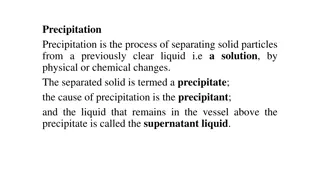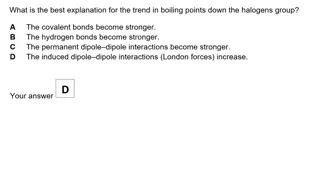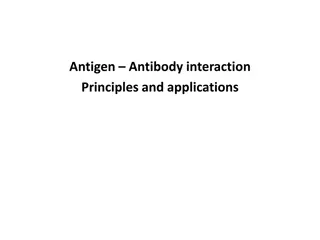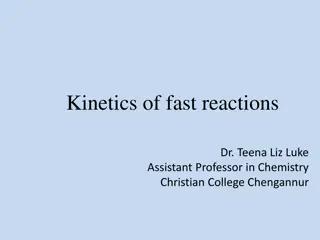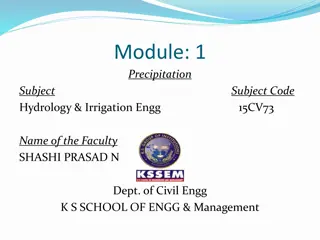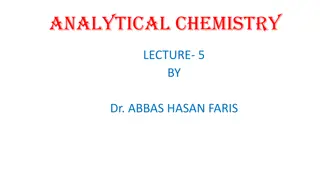Understanding Precipitation Reactions in Analytical Chemistry
Precipitation reactions play a crucial role in analytical chemistry, where cations and anions combine to form insoluble solids called precipitates. By following solubility rules, scientists can predict these reactions, aiding in identifying ions present in solutions. Properties, formation, and equilibrium constants like solubility product constants are key aspects discussed in this insightful lecture.
Download Presentation

Please find below an Image/Link to download the presentation.
The content on the website is provided AS IS for your information and personal use only. It may not be sold, licensed, or shared on other websites without obtaining consent from the author. Download presentation by click this link. If you encounter any issues during the download, it is possible that the publisher has removed the file from their server.
E N D
Presentation Transcript
Analytical Chemistry lec.7 22/3/2020 Prof. . Dr./ Nadia Y. Ahmed Emeritus Prof. of Biochemistry, Fac. of Agric. Benha Univ. Dr/ Nesreen S. Salim
PRECIPITATION REACTIONS Precipitation reactions occur when cations and anions in aqueous solution combine to form an insoluble ionic solid called a precipitate. Whether or not such a reaction occurs can be determined by using the solubility rules for common ionic solids. Because not all aqueous reactions form precipitates, one must consult the solubility rules before determining the state of the products and writing a net ionic equation. The ability to predict these reactions allows scientists to determine which ions are present in a solution, and allows industries to form chemicals by extracting components from these reactions.
PROPERTIES OF PRECIPITATES Precipitates are insoluble ionic solid products of a reaction, formed when certain cations and anions combine in an aqueous solution. The determining factors of the formation of a precipitate can vary. Some reactions depend on temperature, such as solutions used for buffers, whereas others are dependent only on solution concentration. The solids produced in precipitate reactions are crystalline solids, and can be suspended throughout the liquid or fall to the bottom of the solution
Precipitation is the formation of a solid in a solution solid formed is called the precipitate A precipitation reaction occurs when water solutions of two different ionic compounds are mixed and an insoluble solid separates out of solution. Eg KCl + AgNO3 KNO3 The precipitate is itself ionic; the cation comes from one solution and the anion from another. AgCl +
Solubility of a compound = concentrations of a soluble species at equilibrium with its insoluble form. If the compound is sparingly soluble, it will produce cation & anion. Eg AgCl slightly dissolved in water. So AgCl has a specific solubility, s = solid phase aq = aqueous phase AgCl (s) Ag+(aq)+ Cl-(aq) The equilibrium constant for the reaction is known as solubility product constant. Ksp(AgCl) = [Ag+][Cl-] Concentration of any solid (AgCl) is constant and is combined in the equilibrium constant to give Ksp
Solubility product constants are used to describe saturated solutions of ionic compounds of relatively low solubility. A saturated solution is in a state of dynamic equilibrium between the dissolved, dissociated, ionic compound and the undissolved solid. we have two reaction (or method ) to determine Precipitation Mohr method or Volhard Method
1- THE MOHR METHOD uses chromate ions as an indicator in the titration of chloride ions with a silver nitrate standard solution. After all the chloride has been precipitated as white silver chloride, the first excess of titrant results in the formation of a silver chromate precipitate, which signals the end point (1). The reactions are: Ag + C l AgCl(s) 2 Ag + CrO4 Ag 2CrO4(s)
By knowing the stoichiometry and moles consumed at the end point, the amount of chloride in an unknown sample can be determined. This report describes experiments aimed at determining the concentration of chloride in a solid sample.
THE VOLHARD METHOD The Volhard method of Ag+ determination is associated with argentometric titrations even though the titrating agent is actually SCN : Volhard titration rxn Ag+ + SCN titrant AgSCN(s) analyte
The indicator in Volhard titrations is Fe3+, which reacts with titrant to form a red colored complex: Volhard indicator rxn Fe3+ + SCN Fe(SCN)2+(aq) indicator titrant red complex
This is a good method for the analysis of Ag+ in solution. We can extend the applicability of this method to anions such as I through the procedure known as back-titration. A measured excess of Ag+ is added to the dissolved sample: Ag+ + I AgI(s) excess reagent analyte
After the precipitation of AgI is complete, the concentration of excess Ag+ titrant is determined by a Volhard titration. The number of moles of I analyte originally present in the solution is easily calculated: mol I = mol Ag+ originally added to solution mol Ag+ as determined by Volhard titration In a similar manner, the Volhard titration method can be used to analyze for a number of anions.
EXAMPLES : What is the ratio of silvers in coin if 2 g need 39.6 ml of KCNS (0.4103 g KCNS dissolved in 100 ml solute for silver precipitation . note that the coin is dissolved first then treated with KCNS in the presence of ferric ions.
KCNS + Ag + AgCNS CNS-+ Ag + AgCNS solution : E.N. of Ag = E.N. of KCNS 1 mol Ag+ = 1 equivalent 1 mol KCNS = 1 equivalent to calculate Normality of thiocyanate (KCNS) = (mass / molecular weight )/ volum = (0.1403 /97.17)/0.100= 0.0422 N E.N. of Ag = E.N. of KCNS = 0.0422 (39.6 /1000) = 0.0167 E.N. of Ag = mass (or weight) / molecular weight 0.0167 = mass (or weight) / 108 So : mass = 108 0.0167 = 1.8039 g . % of Ag = (pure mass total mass ) 100 = (1.8039 2) 100 = 90.2 %
Solution of acidic potassium oxalate its normality as acid equal 0.2 N what is its normality when used to precipitate oxalate , what is the weight of Ca2C2O4 (calcium oxalate) precipitate when one milliliter of solution with CaCl2. Solution : 1 mol KHC2O4 = 1 equivalent (as acid) 1 mol KHC2O4 = 2 equivalent (as precipitate) E.N. of CaC2O4 = E.N. of KHC2O4 E.N. of CaC2O4 = 0.2 (1/1000) = 0.0002 E. Weight of CaC2O4 = 0.0002 (128/2)= 0.0128 g
What is the number of sodium chloride milliliters (normality equal 3 ) . 3 N needed for preicipitating 500 ml of silver in silver nitrate solution . Solution: E.N. of NaCl = E.N. of Ag Volum normality = weight of silver/ E.W. V 3 = ((500/1000) /108) V = 1.5 ml






